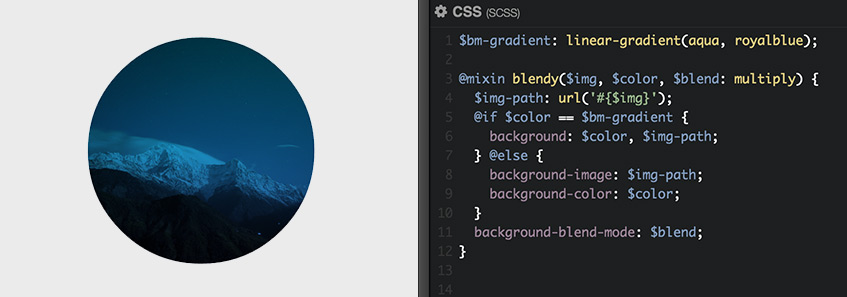CSS blend modes are a new feature that let us blend an element’s background layer with another layer. They’re commonly used for blending a background image with a background color.
In this post, we’ll take a look at a simple blend mode mixin I recently created and used on several Sass projects.
Using blend modes
When we use the background-blend-mode property on an element, it mixes the background image and color together based on the blend mode we set.
The simple version of the mixin accepts three arguments: the image path, background color, and blend mode:
@mixin blendy($img, $color, $blend) {
background-image: url('img/#{$img}');
background-color: $color;
background-blend-mode: $blend;
}Now we can include the blendy mixin in any rule that needs a background blend, like this:
.blend {
@include blendy("mountains.jpg", firebrick, multiply);
width: 200px;
height: 200px;
border-radius: 50%;
background-size: cover;
}What about gradients?
What’s great about blend modes is that they also allow blending between images and gradients. This can create some interesting blending effects.
First, we’ll declare a variable for our blend mode gradient:
// Blend mode gradient
$bm-gradient: linear-gradient(aqua, royalblue);Next, we’ll need to adjust the code in our mixin to accommodate gradients. Since gradients are actually background images — not colors, let’s add an @if/@else condition that displays multiple background layers if we pass $bm-gradient as the $color argument:
@mixin blendy($img, $color, $blend) {
$img-path: url('#{$img}');
@if $color == $bm-gradient {
background: $color, $img-path;
} @else {
background-image: $img-path;
background-color: $color;
}
background-blend-mode: $blend;
}This time, instead of a color value, let’s pass the gradient variable:
.blend {
@include blendy("mountains.jpg", $bm-gradient, multiply);
...
}Finishing touches
Currently, we’re limited to one blend mode gradient and we want the mixin to accept values from a variety of variables. For example, any of these:
// Blend mode gradients
$fancy-grad : linear-gradient(aqua, royalblue);
$transp-grad : linear-gradient(black, transparent);
$snarky-grad : linear-gradient(firebrick 40%, blue);To do that, we’ll pass both $color and a new argument,$grad, as optional arguments set to null by default. And, since multiply is the most widely used blend mode (at least for me), let’s set the default blend mode value to multiply.
@mixin blendy($img, $color: null, $grad: null, $blend: multiply) {
$img-path: url('img/#{$img}');
@if $grad {
background: $grad, $img-path;
} @else {
background-image: $img-path;
background-color: $color;
}
background-blend-mode: $blend;
}Now we can simply specify the image and the blend color or gradient we want to display:
.blend {
@include blendy("mountains.jpg", #00bfff);
}
.feat {
@include blendy("featured.jpg", $grad: $fancy-grad);
}Check out the final result on CodePen:
See the Pen LEQWev by Guil H (@Guilh) on CodePen.
Tweet this article